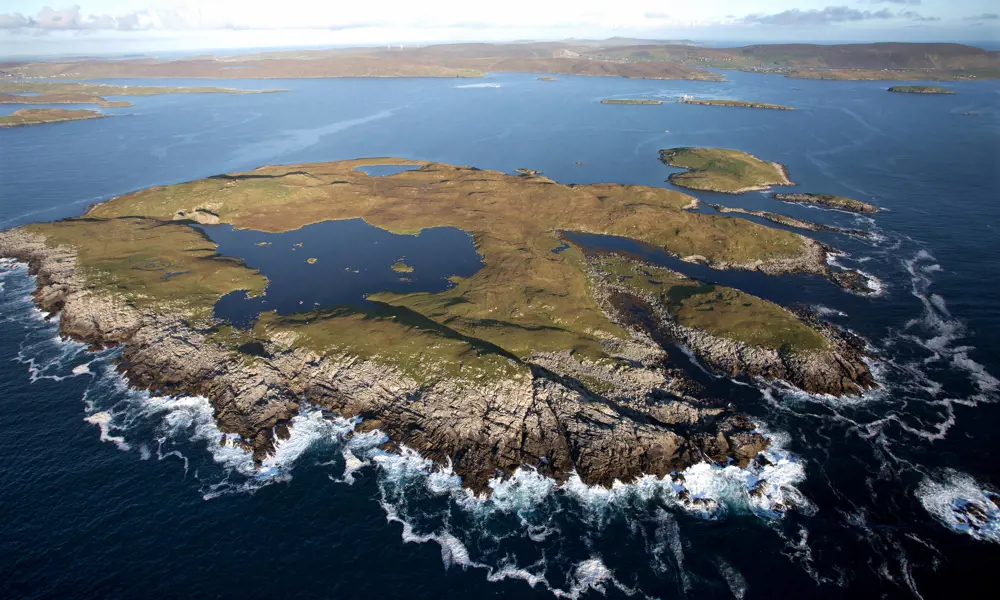
In deep water: The UK's first subsea-to-shore gas plant
Everything about Total’s £3.5 billion Laggan-Tormore gas project is impressive. Part of it, the £800 million Shetland Gas Plant, was the UK’s largest construction project since the London 2012 Olympics. In its entirety, it is also significant for being the first plant in the UK to adopt a subsea-to-shore development with no offshore surface infrastructure and is the first to use this technology on such a scale.
the £800 million Shetland Gas Plant, was the UK’s largest construction project since the London 2012 Olympics
The project involved developing two gas fields, Laggan and Tormore, lying in the deep waters off the northwest of Shetland, installing underwater export pipelines and building a massive new gas-processing plant on the Shetland Islands. Formally opened in May 2016, the Laggan-Tormore gas project was undertaken in the harshest weather conditions imaginable and was completed in just six years, first coming on line in February 2016. When working at full capacity, Laggan-Tormore will supply between 8% and 10% of the UK’s gas.
Laggan and Tormore are gas and condensate fields that are located in the waters between the Faroe Islands and the Shetlands Islands. Both reservoirs are made up of thin layers of gas-bearing sand, which are separated by thin layers of shale. The fields’ reserves are estimated to exceed one trillion cubic feet of gas and condensates (about 230 million barrels of oil equivalent), making it one of the biggest natural gas finds in British deep waters. This set of gas fields is the first to be developed in the Atlantic margin, a region that until now was known primarily for its oil production.
First discovered in 1986, the Laggan field was licensed to Total in 1995, and two appraisal wells were completed in 2004 to determine the physical extent, reserves and likely production rate, with one recording a good flow rate of 37.8 million cubic feet of gas per day.
The discovery of the Tormore field in 2007 yielded a good average test flow rate of 32 million cubic feet of gas a day, which was considered to be sufficiently promising.
Project details
🚧 Ownership, location, size and cost
- Ownership: Total E&P UK (60%), SSE E&P UK (20%) and Dong E&P (UK) (20%)
- Operator: Total E&P UK
- Location of fields: Laggan lies 16 kilometres from Tormore at a water depth of 600 metres. The fields lie 125 kilometres northwest off the Shetland Islands
- Size: Total field reserves estimated at one trillion cubic feet and condensates (about 230 million barrels of oil equivalent)
- Cost: £3.5 billion
Subsea-to-shore development
Total’s choice of subsea development of the LagganTormore gas fields was innovative in UK waters. It was deemed to be essential for a number of reasons, including the depth of the gas fields at 600 metres below the surface and to meet the requirements of the climate, which is similar to Southern Alaska with an average wind speed of 15 miles per hour and hurricanes common in winter. The temperature of the seawater at -1°C and fast currents, at speeds of 0.64 metres per second, also influenced the decision.
developing a subsea production system with wells that are operated by semiautonomous remote systems at a depth of 600 metres, located more than 140 kilometres offshore, presented complex engineering challenges
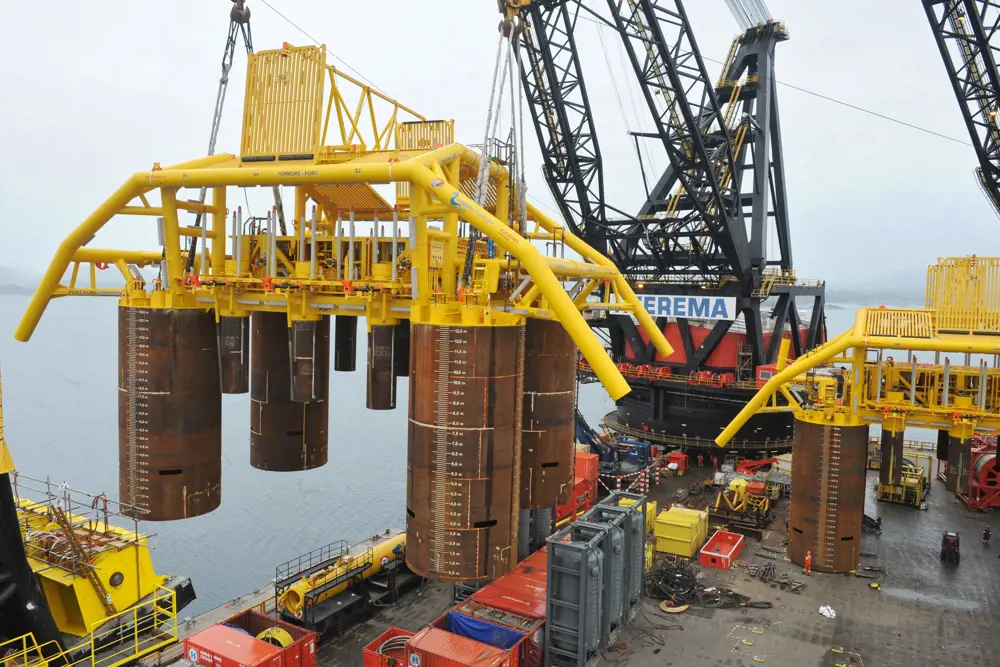
The semi-autonomous subsea production system consists of two six-slot manifold templates that were installed on the seabed on each of the fields. Each manifold is made up of pipes and valves to safely transfer gas from the wellhead into the pipeline © Total
The extreme weather conditions, depth of the wells and speed of the current made it impracticable to export the gas from the offshore fields using an FLNG (floating liquid natural gas) vessel to collect the gas, process it, then store and offload the gas onto LNG tankers.
The design concept, involving construction of a subsea pipeline network, was a safer and more reliable solution. However, developing a subsea production system with wells that are operated by semiautonomous remote systems at a depth of 600 metres, located more than 140 kilometres offshore, presented complex engineering challenges.
The subsea template, a large steel structure that acts as a foundation base for various modular underwater structures so that subsea `trees’ and `manifolds’ can be attached (imagine a Lego base-plate for the foundation of a building), was installed in 2012. Upon completion, the West Phoenix, a semi-submersible rig operated by North Atlantic Drilling, drilled seven production wells: four on Laggan and three on Tormore.
By this stage, the project had achieved two `firsts’ in UK waters: the installation of a deep-water subsea production system rather than a conventional platform and the lengthiest tieback (pipeline network) between offshore wells and an onshore terminal. This use of subsea tiebacks is an increasingly popular technique, especially in areas of deep water such as off the north-western Australian coast.
In order to access the gas, Total installed a semiautonomous subsea production system consisting of two sixslot manifold templates on the seabed, one for each field. Each manifold is a large piece of equipment that is made up of pipes and valves to safely transfer gas from the wellhead into the pipeline through a series of chokes, isolation valves, multiphase flow meters, chemical injection, and control modules.
Two 10-inch headers, connected to two 18-inch import lines, collect gas from the individual wells. The subsea production system offers the flexibility for gas from any well to flow into either of these two production import lines.
Production from these fields began in February 2016: five wells are already producing over 90,000 barrels of oil equivalent per day. A 143-kilometre export pipeline carries the output to the Shetland Gas Plant.
Installation
Each manifold template is approximately 30 metres wide, 40 metres long, 21 metres high and weighs 900 tonnes, and was designed to anchor the subsea manifold to the seabed and ensure that they are not a risk to the local fishing fleet. The templates are anchored to the seabed through friction where the steel meets large suction cans.
Such deep waters precluded the use of divers to install the production system on the seabed. Instead, Heerema Marine Contractors handled the transportation and installation of the production systems on the Laggan and Tormore gas fields, using its Thialf heavy-lift vessel. Subsea work was subcontracted to Aberdeen-based Specialist Subsea Services (S³), which provided and operated the remotely operated underwater vehicles (ROVs) on the site for subsea installation work. The ROVs are tethered underwater mobile devices operated from a surface vessel via a cable, similar to drones but working underwater. ROVs are usually fitted with sonars, magnetometers, a still camera, a manipulator or cutting arm, water samplers, and instruments that measure water clarity, water temperature, water density, sound velocity, light penetration and temperature.
Such deep waters precluded the use of divers to install the production system on the seabed
With a life expectancy of some 20 years, it is possible that if the technology develops sufficiently then a subsea compression booster unit may eventually be installed to extend the life of both fields. Over time, wellhead pressures decline and the pipeline export flow falls below a critical value, necessitating installation of compression boosters at each wellhead and one for each export pipeline. It is then possible to increase production and recovery from the reservoir by reducing backpressure on wells and increase the flow rate in the export pipelines.
Laying the pipeline
The pipeline part of the project consists of two distinct sets of pipeline networks: the network connecting the gas fields to the Shetland Gas Plant for processing and the Shetland Island Regional Gas Export (SIRGE) pipeline system, which transports processed gas from the Shetland Gas Plant to the UK mainland.
The network connecting Laggan and Tormore to Shetland comprises three pipelines and a communication or control umbilical. On the seabed, this network consists of the two 18-inch diameter flowlines that carry gas from the fields to Shetland for processing and an 8-inch diameter pipeline carrying MEG (mono ethylene glycol), used as ‘antifreeze’ in the flowlines, from the Shetland Gas Plant to the Laggan-Tormore field’s production sites. Gravity causes the contents in the gas pipeline to separate into gas in the top half of the pipe, and the heavier gas liquids along the bottom half. The controlumbilical is deployed on the seabed to monitor and supply necessary control, energy and chemicals to the subsea infrastructure, including the remote-controlled operation.
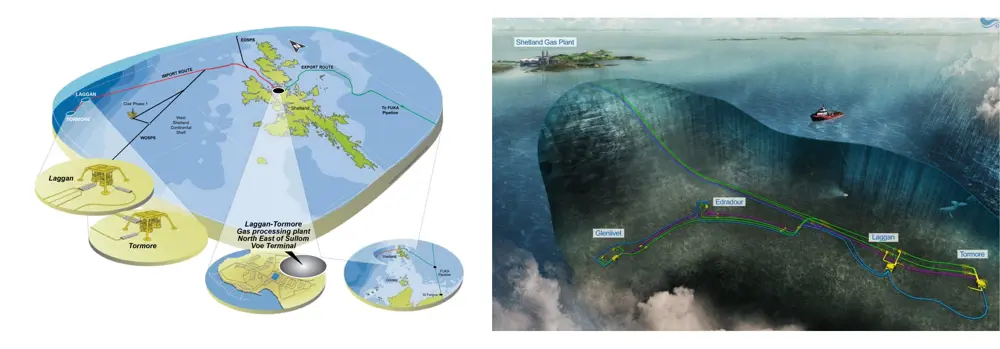
The subsea 143-kilometre pipeline from the Laggan-Tormore fields to the Shetland Gas Plant is a first for the UK. Once carried to the processing plant, the gas is exported to the UK mainland by the SIRGE pipeline. The subsea system and pipeline has the capacity to also link up the Glenlivet and Edradour fields that are currently being explored by Total © Total
Both the MEG pipeline and control-umbilical are buried under newly laid stone to protect them while the gas export pipelines are exposed to the elements. The second pipeline, the SIRGE system pipeline, consists of the 225-kilometre, 30-inch diameter gas export pipeline that leaves the Shetland Gas Plant to link up with the subsea gas junction on the Frigg-UK (FUKA) pipeline. From here, the gas is transported to the St Fergus Gas Terminal near Aberdeen and then distributed to the UK market. The SIRGE pipeline has the capacity to transmit at least 665 million standard cubic feet of Laggan-Tormore gas per day at a temperature of 15°C.
The entire pipeline network was constructed from an estimated 200,000 tonnes of high-grade steel, and the pipes are fully protected internally by a three-layer polypropylene anti-corrosion coating, internal flow-efficiency coating and concrete-weight coating. This pipeline network is regularly inspected and can be cleaned by using a ‘pig’, a device that is inserted into the pipeline to perform various maintenance operations. They are used in oil and gas pipelines to clean the pipes and there are also ‘smart pigs’ used to inspect pipelines for detecting leaks that can be explosive and dangerous to the environment. They do not usually interrupt production, although some product can be lost when the ‘pig’ is extracted from the pipe.
Seawater temperatures of at least -1°C surrounding the two export pipelines presented the chemical engineers with the need to prevent crystallisation of the gas output during its journey to the Shetland Islands. The solution was to inject MEG to stop the condensate freezing at the start of its journey. When the gas arrives at the Shetland Gas Plant for processing, the MEG is removed and pumped back to the wellheads to start its journey again.
Seawater temperatures of at least -1°C surrounding the two export pipelines presented the chemical engineers with the need to prevent crystallisation of the gas output during its journey to the Shetland Islands
The two pipelines linking the gas fields with the Shetland Gas Plant were laid using a range of vessels. In May 2010, Subsea 7 (a seabed-to-surface engineering construction and services contractor to the offshore energy industry) was awarded the contract to supply subsea infrastructure items. Its principal tasks included the fabrication and installation of the 143-kilometre 8-inch and 2-inch piggybacked service pipelines (where the secondary pipeline is attached to the main one using a clamp), as well as the installation of the two control-umbilicals with all their associated structures and tie-ins.
The world’s largest pipelaying vessel, the 300-metre long Solitaire was used to lay the 243-kilometre SIRGE system pipeline linking the Shetland Gas Plant with the FUKA pipeline. The section on land was laid in an excavated trench, then covered with steel netting for reinforcement before having the spoil from the excavation laid on top. Once in the sea, the concrete coating ensured that the pipeline was heavy enough to sink. However, for its first 300 m underwater, the pipeline lies in a two-and-ahalf-metre deep trench that has been specially created from a stone causeway extending from the beach at Firths Voe. The trench was dug by the backhoe dredger Abercoserver, a hydraulic excavator, with the ocean-going tug Baloo working at the excavation. Sophisticated sonar equipment was used to guide digging from the ships in order to avoid the Brent pipeline, which also enters the sea from this beach.
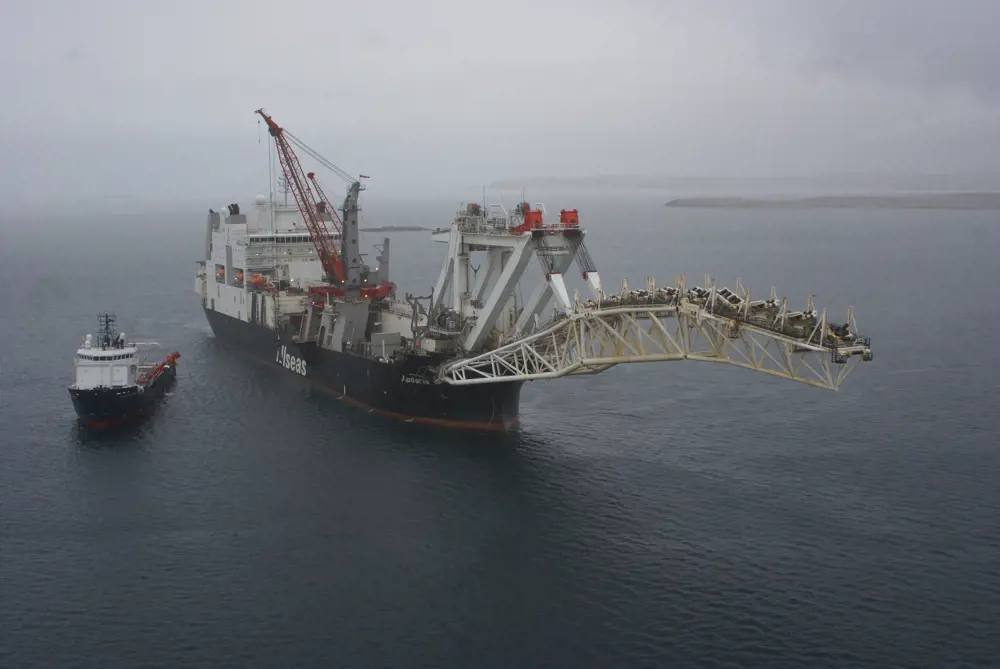
A major part of the Laggan-Tormore project was the offshore installation of two parallel 18-inch flowlines (141 kilometres each) and a 225 kilometre 30-inch export pipeline, all complete with inline valve structures © Total
Shetland gas plant
Construction on the £800 million Shetland Gas Plant began in 2010 and was handed over to Total by lead contractor, Petrofac Offshore Engineering & Operations, in December 2015 so that the complete range of command and control systems could be tested. The first gas arrived in February 2016, and in April, the second gas compressor came online.
The plant is located next to the Sullum Voe Terminal for oil and gas on the main island of Shetland. It took more than two years to complete, creating 800 jobs during construction, and employs 70 people today.
The plant is situated on a Greenfield site that presented engineers with a number of challenges before construction could begin. In preparation, a substantial amount of earth needed to be moved and the bedrock was terraced, a soil conservation practice consisting of ridges and channels to prevent rainfall runoff on sloping land from accumulating and causing serious erosion. The soil and peat that was excavated from the back of each level was then used to extend the front of each terrace, supplemented by material from local quarries.
In order to maximise the long-term sustainability of the plant, two large peat stores were designed and created to accommodate some 650,000 cubic metres of material excavated from the site during these pre-construction phases. This means that the peat was not destroyed and its CO2 remains safely locked in thus avoiding the inevitable emissions that transportation would cause. At the end of the plant’s life, these stores can be removed and the peat can be recycled to restore the site to its predevelopment condition. There was also rigorous protection of the local wildlife and the archaeology of the site.
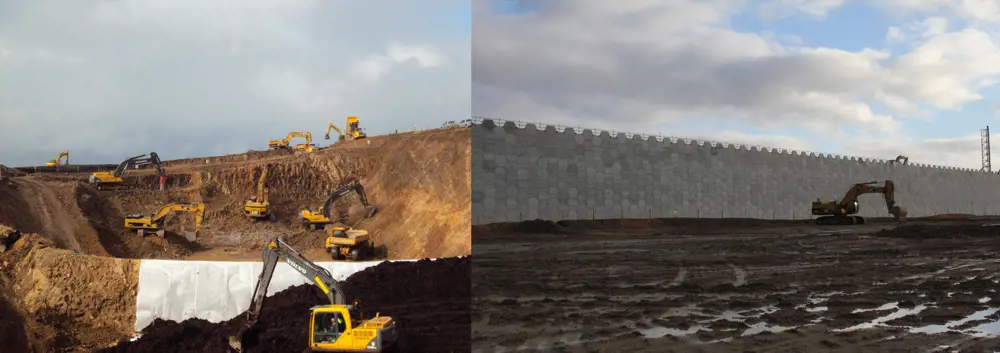
Before construction could begin on the Shetland Gas Plant, a substantial amount of earth was moved. The soil and peat that was excavated was used to extend the terracing of the bedrock and two large peat stores were designed and created to accommodate the material so that the peat can be recycled to restore the site to its predevelopment condition at the end of the plant’s life © Total
The plant is situated on a Greenfield site that presented engineers with a number of challenges before construction could begin
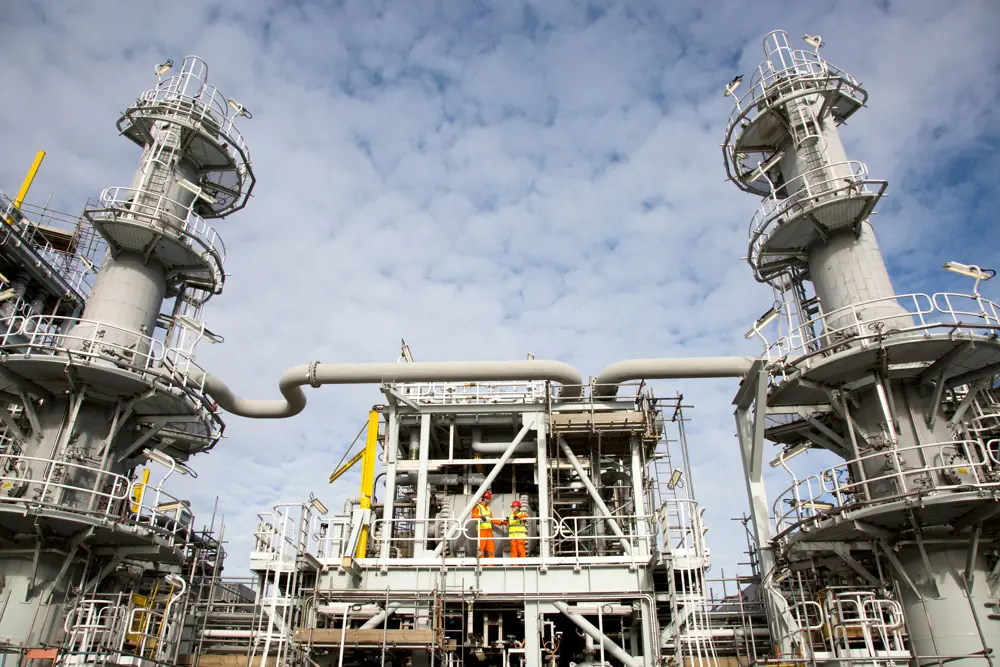
The Shetland Gas Plant took more than two years to complete, creating 800 jobs during construction, and employs 70 people today © Total
The Shetland Gas Plant is designed to separate LagganTormore raw gas using a threephase separator system. The well fluid is separated into gas, oil and water with the three fluids being discharged separately. The associated liquid hydrocarbons are exported to the Sullom Voe Terminal, and treated gas from the plant is exported to the FUKA pipeline in the North Sea via the SIRGE pipeline.
Up to 500 million standard cubic feet of gas can be processed each day; an amount that is enough to meet the energy needs of two million homes. In anticipation of the Edradour field coming online in 2017 and Glenlivet in 2018, modifications will be made to the Shetland Gas Plant’s controls and mercury removal facilities will need to be installed.
Everything that goes on in the plant is controlled roundthe-clock by a team based in the onsite control room. The team is responsible for continuous monitoring to ensure the safe operation of the plant’s systems, which includes its effluent water treatment and oil water treatment packages. For training purposes, and in preparation for different operational scenarios, the team has access to process plant simulators, a pipeline, the Integrated Control and Safety Systems, and the Subsea and Topside Control System.
Site statistics
👷 The workforce and materials required to build the Shetland Gas Plant
The Shetland Gas Plant occupies an area of approximately 540,000 square metres and the build required:
- at peak, a construction workforce of around 2,000
- 62 modules, weighing an average of 250 tonnes each
- construction of a 2.4 kilometre road to access the new plant
- 39,000 cubic metres of concrete
- 3,900 tonnes of steel
- 15,000 metre of underground glass-reinforced epoxy pipes
- 1,500 kilometre of electrical and instrument cabling
- a 90-metre-high flare.
Future developments
The whole pipeline system has been designed and built to accommodate increased production from existing and future fields. In anticipation of future production, passive junctions have been fitted with hot tap tees that will enable future branch pipelines to be fitted to the Laggan-Tormore pipeline network. In fact, the Edradour and Glenlivert fields, which are named after Scottish whiskies, are only viable prospects because of the pipeline network built for Laggan-Tormore.
Development of the Edradour gas field was officially launched in July 2014 and production is expected to start in 2017 when the pipeline link to the existing Laggan-Tormore fields is ready. The plan is for production to continue for 15 years, delivering 17,000 barrels of oil-equivalent per day at peak.
There are also ongoing plans to develop two wells on the neighbouring Glenlivert field tied back to the Edradour field’s facilities via a 17-kilometre production pipeline. The reservoir fluid in the Glenlivert field is estimated to be a light gas-condensate with a condensate-gas ratio of approximately 16 barrels per million standard cubic feet. Drilling of the wells has begun and the pipelines, subsea structures and umbilical line will be installed between 2016 and 2017, while tie-in and commissioning will take place in mid-2018.
As to the future, any gas from fields found further west in Faroese waters could be transmitted to the UK mainland by the existing infrastructure put in place for the LagganTormore fields.
***
This article has been adapted from "In deep water: The UK's first subsea-to-shore gas plant", which originally appeared in the print edition of Ingenia 68 (September 2016).
Contributors
Nicholas Newman
Author
David Hainsworth is Operations Manager of Exploration and Production at Total UK. Before joining Total in 1995, he worked as a safety consultant in the nuclear and oil and gas industries. David holds a degree in chemical engineering from the University of Edinburgh and is a member of the Institution of Chemical Engineers.
Keep up-to-date with Ingenia for free
SubscribeRelated content
Civil & structural

Building the Shard
The Shard is one of London's most iconic buildings. The tallest in Western Europe, it was designed by Italian architect Renzo Piano and dominates the city’s skyline. Ingenia spoke to John Parker, project director for structural engineers WSP, who outlined the engineering decisions made in building the enormous steel and glass structure.

FlexiArch
Arch bridges are strong, durable and require little maintenance. However, very few had been built since the early 1900s until the FlexiArch was developed and launched in 2007. Now, there has been a minor renaissance for this ancient form of construction.

Creating user-friendly buildings
For Michelle McDowell, a former Business Woman of the Year, a passion for joined-up design thinking and building information modelling with a user-friendly approach has enabled her to pioneer revolutionary changes in her field.

Troja Bridge
In November 2014, one of the world’s largest network arch bridges was officially opened in Prague. The UK may soon have its first network arch bridge if the go-ahead is given for a new rail project in Manchester.
Other content from Ingenia
Quick read

- Environment & sustainability
- Opinion
A young engineer’s perspective on the good, the bad and the ugly of COP27

- Environment & sustainability
- Issue 95
How do we pay for net zero technologies?
Quick read

- Transport
- Mechanical
- How I got here
Electrifying trains and STEMAZING outreach

- Civil & structural
- Environment & sustainability
- Issue 95